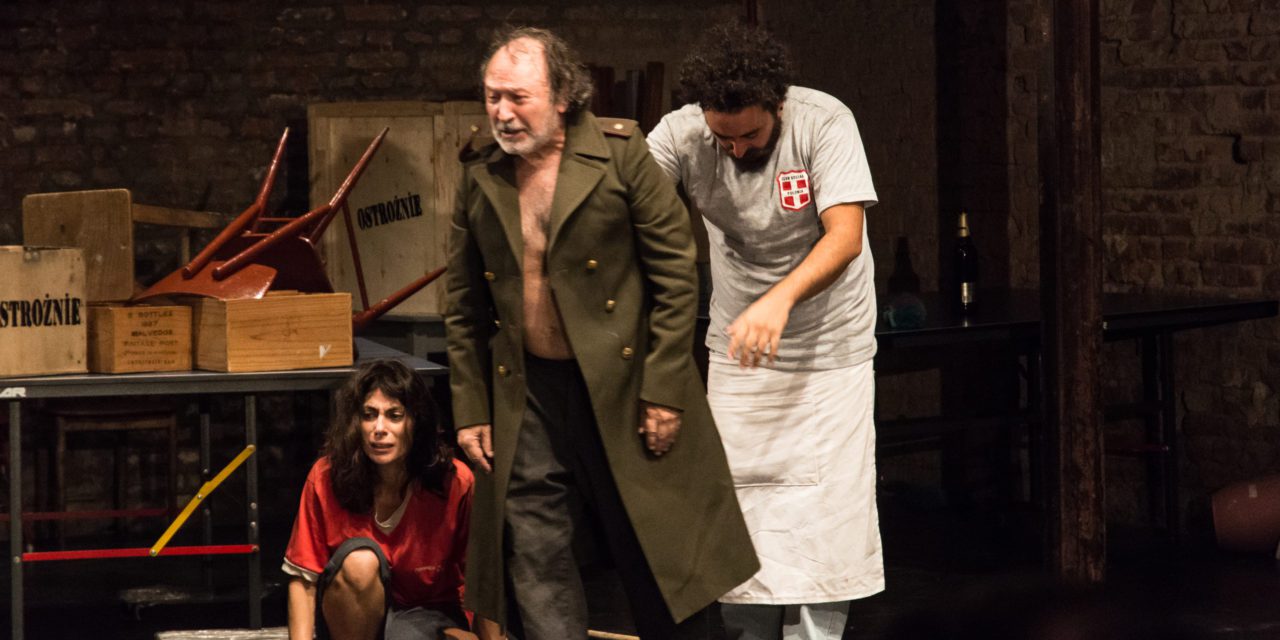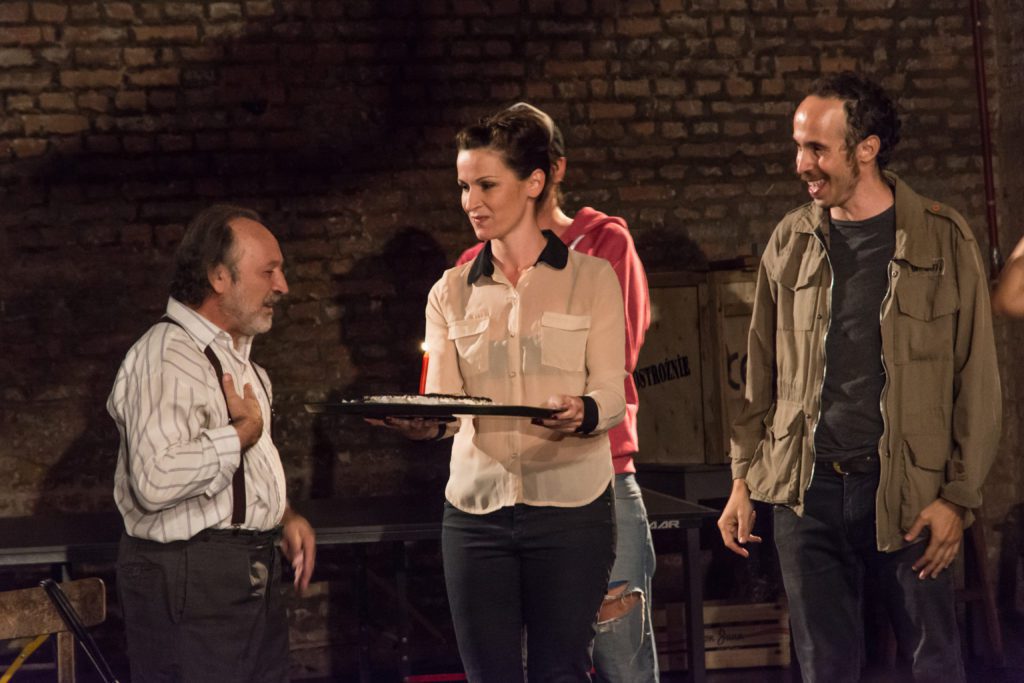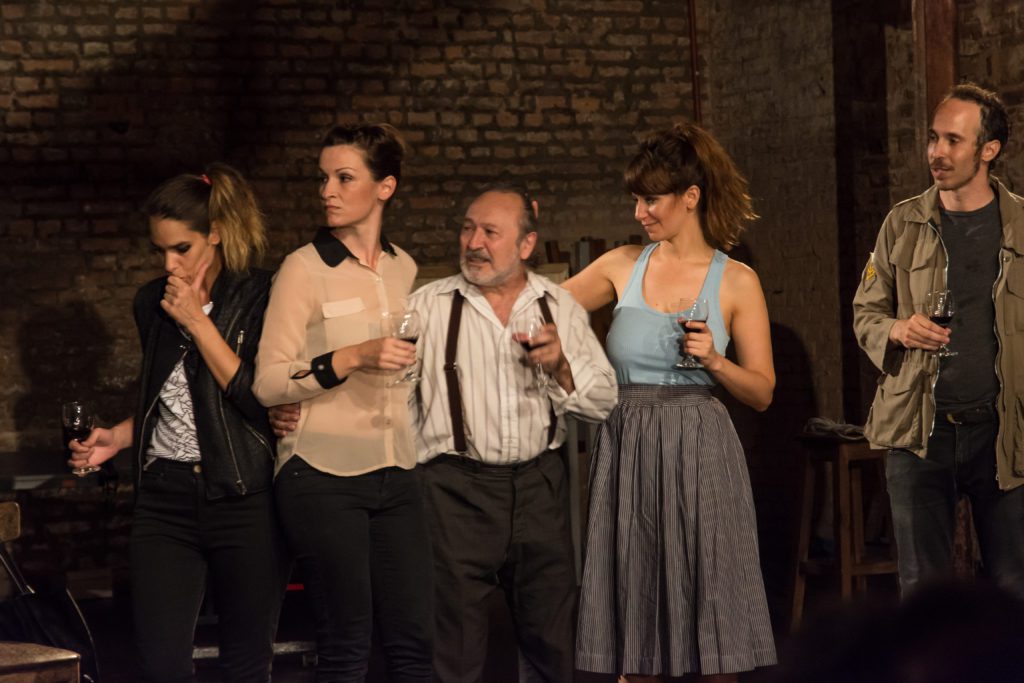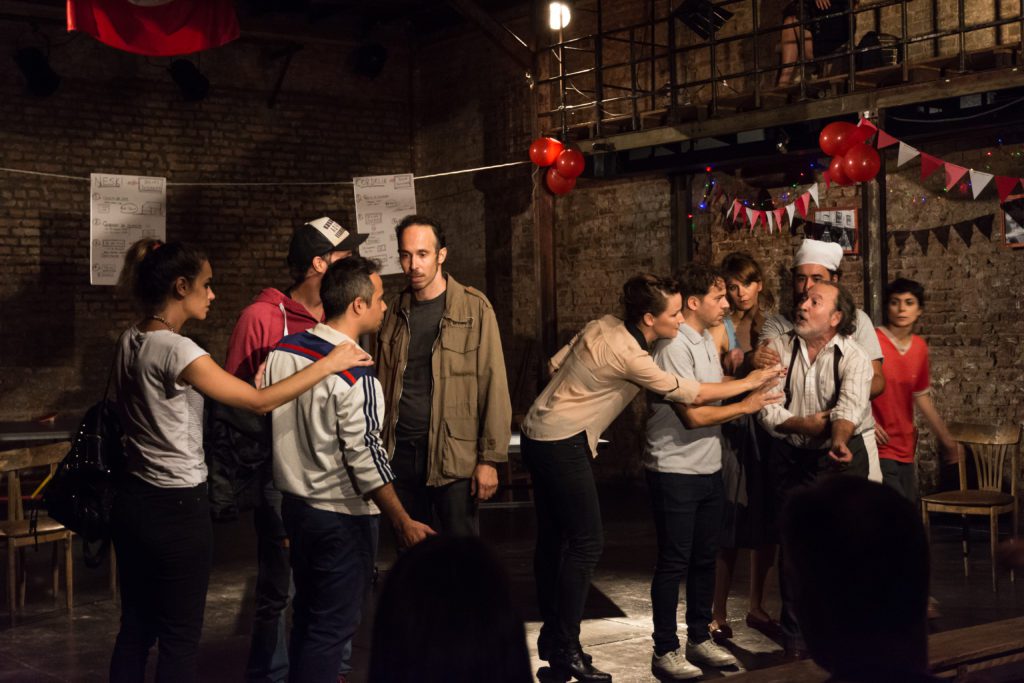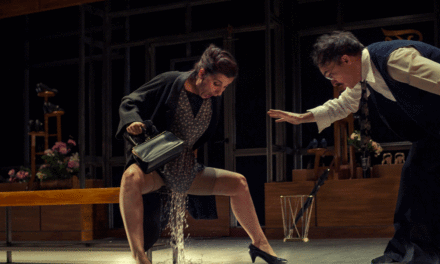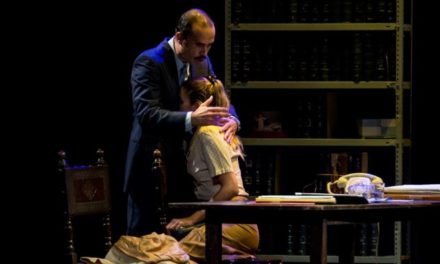It’s a beautiful Sunday morning in Buenos Aires, and while most tourists are rushing off to the San Telmo street market, the local porteños are enjoying a relaxed morning at home, heading out for brunch, or perhaps preparing for the afternoon asado. The hard-core milongueros are likely sleeping in after a sultry evening of tango at some all-night milonga. As of February 2017, there is a new, intriguing Sunday ritual playing out at high noon in Almagro, at the Espacio Callejón Theater: La fiesta del viejo, by Fernando Ferrer. Since its premiere five months ago, this riveting, insightful, and ambitious play has caught on like wildfire and continues to sell out. Theater aficionados who have not yet seen this outstanding production must now purchase tickets weeks in advance.
La fiesta del Viejo offers the public a uniquely captivating, sensorial experience. Upon arrival at Espacio Callejón, spectators are served wine and knishes as they enter the main theater space to take their seats. We are, after all, attending a “party,” and the initial mood is festive. As audience members settle in, juggling their refreshments while trying to review the program, there is already a lively game of ping pong in progress on stage. Decorations are up, and a few characters tend to the final details.
La fiesta del Viejo takes place in a social club in Buenos Aires, in the middle-class neighborhood of Almagro, on the occasion of the owner’s birthday party. The club is affectionately named “Polonia” (Poland) in honor of the protagonist’s native land, and the red and white flag gracing the stage is a constant reminder of his heritage. It is suggested that the main character hails from a Jewish family, persecuted during World War II, and that he eventually fled the horrors of the war to start a new life in Buenos Aires. Until recently, the protagonist has enjoyed a fairly successful business with his bar/restaurant and, equally important, over the years has developed strong personal ties to the surrounding community. Throughout the play, the protagonist is simply referred to as “Viejo”, which in Spanish not only means an old man, but also serves as a colloquial term for one’s father (“mi viejo”). This initial lack of a specific name for the main character may lead to premature conclusions, as the story could be about the difficulties of any hard-working immigrants. Yet when Viejo’s family—especially his three daughters— arrive for the celebration, the elderly man informs them that he also plans to announce decisions regarding their inheritance. Thus we find not just any father, but a modern parallel to Shakespeare’s King Lear. As the story develops, multiple factors such as a daughter named “Cordelia,” and an employee named “Kent,” effectively confirm this suspicion.
Although Ferrer’s interpretation of the Shakespearean tragedy integrates some key plot elements (the division of family wealth, the narcissistic patriarch’s demand that each daughter declares her love for him, violence sparked by materialism, greed, and jealousy. . .), he has skillfully adapted the story to a contemporary Argentine social, economic and demographic context. In lieu of the original royal family and ancient British setting, Ferrer’s play features an immigrant business owner in the Argentine capital, arranging his final affairs in order to ensure his legacy. Similarly to Lear, Viejo suffers abuse by family members, but in this case, they lock him up in his establishment in a cruel effort to evict him from his own property. Additionally, Viejo’s decent into madness is dramatized through his progressive decline due to Alzheimer’s. Throughout the play he fades in and out of reality, often retreating into memories of his parents when he was a young man in Poland. It is through these hallucinations and haunting references to the war and “the trains” that Ferrer introduces the terror of the Holocaust as well. Nevertheless, Ferrer does maintain the source text’s core conflict of opposing social, individual, and family values. Viejo continues to represent the central themes of tradition, legacy, and dedication to family. Likewise, his daughter Cordelia, who is passionate about great literature, has a deep appreciation for humanistic principals. As a result, she seems indifferent about the family inheritance and, unlike the hypocritical, effusive declarations of her sisters, only offers a simple expression of love for her father. This, of course, costs Cordelia her inheritance. In contrast to the altruistic values of Viejo and Cordelia, daughters Regina and Neski, together with their spouses, are driven and blinded by their materialism, greed, and capitalistic pursuits. They will let nothing stand in the way of their inheritance or their plans to cash in and sell their father’s club to urban developers.
Although evidently influenced by Shakespeare’s King Lear, La fiesta del viejo is an extraordinary play that stands alone on its own merit, and will surely continue to draw a full house throughout the current theater season in Buenos Aires. Ferrer’s creative version of the tragic tale successfully brings it into the 21st century and makes it more relevant to present day audiences of all ages. Moreover, the critical perspectives that underscore these works will continue to be pertinent for generations. In addition to his solid, well-developed script, Fernando Ferrer is to be commended for his excellent work as a director. Immediately noticeable is his astute use of the versatile, unique theater space characteristic of the Espacio Callejón. The realistic stage set stands out for its introduction of key symbolic elements such as the initial ping-pong game foreshadowing cut-throat family competition later in the play. Among other impressive artistic elements are the oneiric, live bandoneón music accompanying scene transitions and various tender moments, as well as the truly fine work with a large cast. Ferrer’s selection of seasoned actor Abian Vainstein for the lead role was particularly notable, as Vainstein gives a visceral and heart-wrenching performance as Viejo. All of these features, and more demonstrate Ferrer’s virtuosity. Finally, Ferrer’s skillful implementation of precision timing among the actors, together with his ability to attain the physical and emotional crescendo of the play, are critical in achieving the jolting, apocalyptic ending that leaves spectators stunned. At the close of the performance, I attended in March, we left the theater feeling dazed and speechless. Luckily we were somewhat revived by the delicious dessert waiting near the exit. After all, what party would be complete without cake?
This post was written by the author in their personal capacity.The opinions expressed in this article are the author’s own and do not reflect the view of The Theatre Times, their staff or collaborators.
This post was written by Susan Berardini.
The views expressed here belong to the author and do not necessarily reflect our views and opinions.

